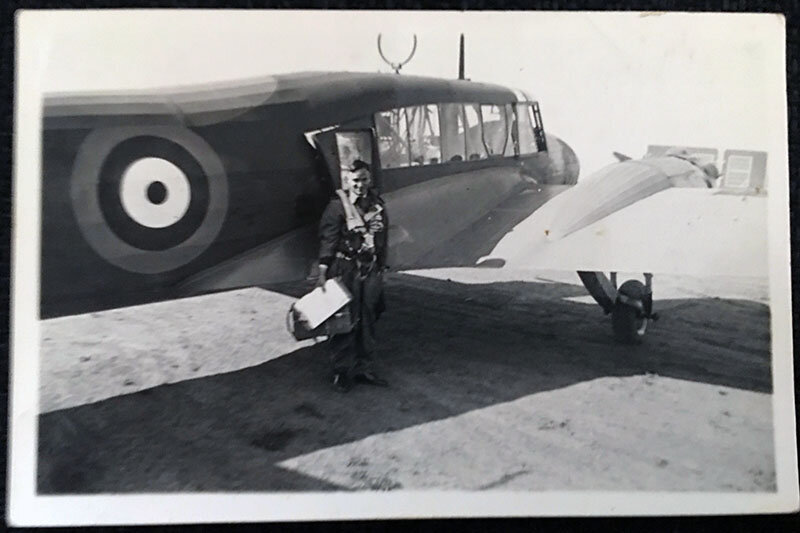Learning to Fly in Prince Albert
George Charity.
I inherited hundreds of pictures going back to the 1930s and five tapes of stories my grandfather, George Charity, recorded in 1978. This story is from Tape One and covers his early days working as a hired hand, the Coca-Cola truck accident, and flight school during the 1930s and early 1940s.
In his early years, George lived in a small home in Oriole, Ontario. He grew up on Leslie Street, a block north of Sheppard Avenue. His father worked at the mill on the north-west corner. Some of that mill remains and is now called “East Don Parkland.”
George’s first encounter with planes was witnessing a crash where the North York General Hospital now stands. He and a friend saw a plane attempt a landing at a field near there. As they watched, it landed and crashed. They saw the pilot get out and walk back to the airfield.
As he grew, George did odd jobs, one of which was painting road posts on Dawes Road on the east end of the city. This would have been in the mid-1930s. While painting, he was hit by a Coca-Cola truck. The accident shattered his leg which required grafting, pins, and a cast.
While in the hospital, a lawyer for Coca-Cola convinced George (who was foggy due to pain killers) to sign a document that waived the company’s liability. I remember him telling me that, after the accident, their house contained no Coca-Cola products. He would only drink Pepsi.
In a cast for almost two years, George took a long time to heal which limited his ability to pursue the career he wanted - Flying.
While he waited for his leg to heal enough for him to pass a medical exam, George learned to weld. He worked at De Haviland in Malton, welding aircraft. He made 80 cents an hour. There, he saw US pilots picking up planes and flying them back to the United States. His determination to become a pilot became even greater.
Once his leg healed, he began applying to flight schools. By the late 1930s, he was on his way by train to Prince Albert, Saskatchewan to attend flight school. He was making $300 a month, and he could not believe he was getting paid to be a pilot. He flew various daytime circuits, navigating by instruments and by landmarks such as lakes and towns. He mentions another pilot, Don Hammond, whom he flew with at this time. He also mentions that the type of plane they flew was the Anson.
After three months George was offered the opportunity for night flight training. He mentions a few occasions that were frightening and led to a fear of night flying. One such incident was when he was flying to Saskatoon. He encountered a low cloud ceiling and heavy turbulence. He couldn’t navigate by land or stars and had to rely on simple instruments and luck. Flying at night helped him get in the flight hours he needed, but he was concerned about getting lost and crashing. On another trip, they were flying a circuit to Melfort and went off course. Landmarks such as the town lights and Lenore Lake could not be seen. Later in the flight, they realized they were ten miles off course. They corrected and headed back to base.
George completed his training by September of that year. He applied at several other bases such as Winnipeg, Malton, and Forestry in Sault Saint Marie. With Malton being close to his family, he originally chose to move there. However, he didn’t like the approach they were using to fly. On one occasion they flew a circuit to Beaverton and the instructors had all the planes flying at the same altitude which introduced safety concerns. He later accepted the job with Forestry in Sault Saint Marie and his wife and children took the train up to join him. He worked at the PAS (Provincial Air Service) base doing shop work until his Buhl 6M CF-OAW aircraft was ready. That spring he, his wife (Alice) and children (Ron and Joan), along with Hugh Alison’s family, flew to the PAS Nakina base in northern Ontario where they would stay for the next three years.
All photos courtesy of the George Charity Collection.
GEORGE CHARITY (1911-1983) was a pilot and engineer in Cochrane District, Ontario. Born in Toronto, George received his pilot’s license in 1940. During World War Two, he served as a Flight Instructor for the Canadian Air Force at Prince Albert, Saskatchewan. He also flew for the Ontario Provincial Air Service at Sault Ste. Marie, 1943-1946. He then worked as a Pilot for Austin Airways, flying through South Porcupine, Hudson’s Bay and Moosonee, Chubb Crater, Churchill, Belcher Island and Baffin Island from 1945 until his retirement in 1975. Charity married Alice May Hill in 1922. Their children were Don, Ron and Joan.
“people stories” shares articles from Folklore Magazine, a publication of the Saskatchewan History & Folklore Society. Four issues per year for only $25.00! Click below to learn more about the Magazine and to find out how to get your story into the blog!





